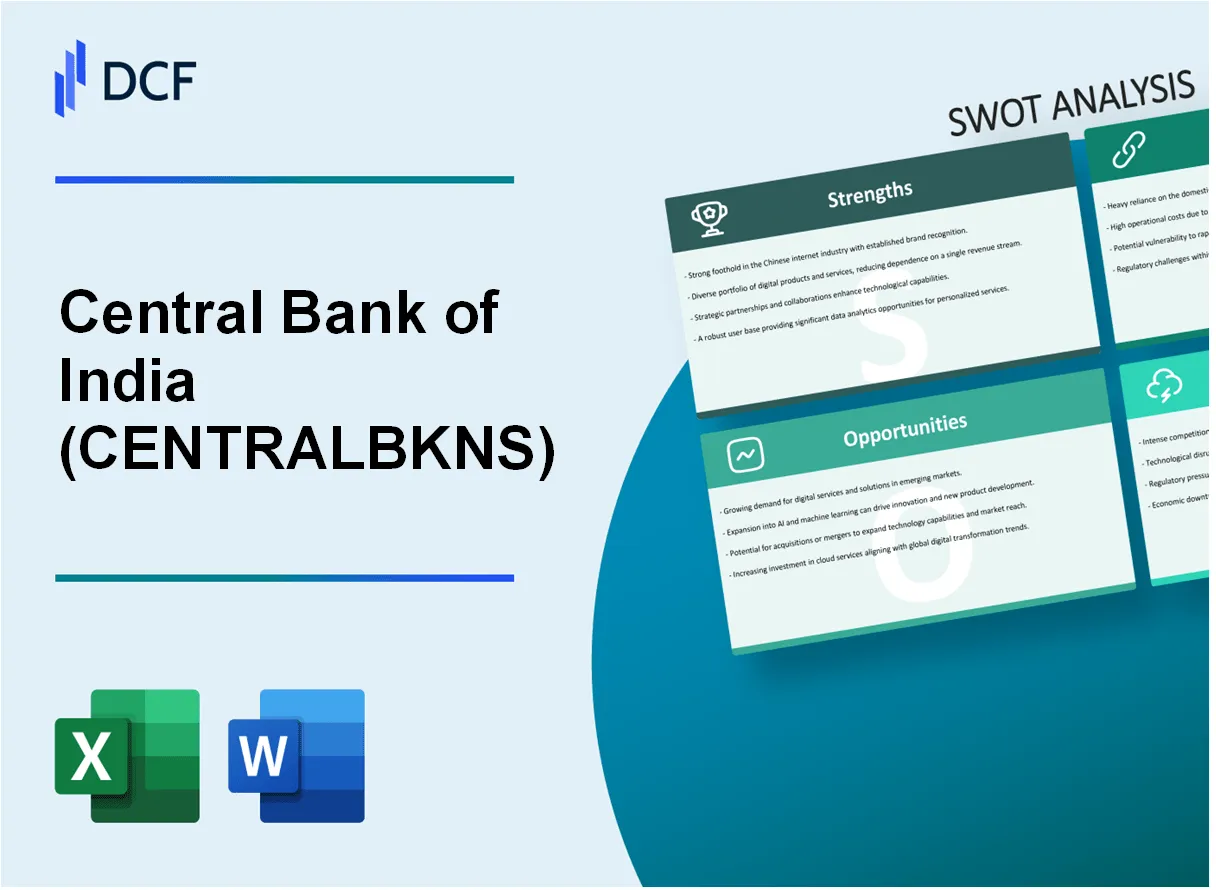In today’s fast-evolving financial landscape, the Central Bank of India stands at a crossroads, balancing tradition and innovation. This SWOT analysis delves into its strengths, weaknesses, opportunities, and threats, providing a comprehensive view of its competitive position. From an extensive branch network to the looming challenges of digital transformation, discover how this iconic institution is navigating the complexities of modern banking.
Central Bank of India - SWOT Analysis: Strengths
The Central Bank of India has a robust presence in the Indian banking sector, primarily evidenced by its extensive branch network. As of October 2023, the bank operates more than 4,500 branches across the country, significantly enhancing its customer reach and accessibility.
Moreover, the Central Bank of India boasts strong brand recognition, being one of the nation’s oldest banks, established in 1911. This legacy contributes to customer trust and loyalty, establishing the bank as a reliable financial institution in the eyes of consumers. The brand's reputation is reflected in its customer base, which has grown to over 100 million account holders.
In terms of financial products, the bank offers a diverse range tailored to meet the needs of various customer segments. Product offerings include savings accounts, current accounts, fixed deposits, loans (personal, home, and vehicle), credit cards, and insurance products. For the fiscal year 2022-2023, the bank reported a total income of approximately ₹33,000 crore (around USD 4.0 billion), with net interest income contributing significantly at approximately ₹18,000 crore (about USD 2.2 billion).
Furthermore, robust regulatory compliance and risk management practices underpin the Central Bank of India's operations. The bank adheres to the guidelines set forth by the Reserve Bank of India (RBI) and maintains a capital adequacy ratio (CAR) of approximately 15.0% as of the latest reporting period. This figure stands well above the mandated requirement of 9.0% by the RBI, signifying solid financial health and risk management.
| Metric | Value |
|---|---|
| Branches | 4,500 |
| Established | 1911 |
| Customer Base | 100 million |
| Total Income (FY 2022-2023) | ₹33,000 crore (USD 4.0 billion) |
| Net Interest Income | ₹18,000 crore (USD 2.2 billion) |
| Capital Adequacy Ratio (CAR) | 15.0% |
| RBI Mandated CAR | 9.0% |
Central Bank of India - SWOT Analysis: Weaknesses
One of the most significant weaknesses of the Central Bank of India is its high percentage of non-performing assets (NPAs), which impacts its overall profitability. As of March 2023, the bank reported a gross NPA ratio of approximately 8.66%, which is considerably higher than the sector average of around 5.0%. This high level of NPAs not only affects the bank's earnings but also leads to increased provisioning requirements, thus straining its financial performance.
In terms of digital transformation, the Central Bank of India lags behind many newer financial institutions. For instance, in 2022, only 30% of its banking services were offered through digital channels, while fintech companies often provide upwards of 80% digital service integration. This limited digital outreach adversely affects customer acquisition and retention, especially among younger consumers who prefer online banking solutions.
The bank's organizational structure is another area of concern. Due to its large size, decision-making processes tend to be slower, which can hinder its ability to respond promptly to market changes. The average time taken for critical decisions can stretch up to 3-6 months, impacting its competitiveness in a rapidly evolving financial landscape.
Furthermore, the Central Bank of India maintains a significant dependence on traditional banking methods which reduces its operational efficiency. As of 2023, the bank derived about 70% of its revenue from conventional banking services, such as branch-based transaction banking, which is increasingly being overshadowed by digital-first approaches adopted by competitors. This reliance on outdated methods poses risks, as customer preferences shift towards more agile and tech-driven banking solutions.
| Weakness | Current Status | Impact on Business |
|---|---|---|
| High NPA Ratio | 8.66% (March 2023) | Decreased profitability, increased provisioning costs |
| Digital Transformation | 30% digital services | Low customer engagement, difficulty in attracting younger customers |
| Decision-Making Speed | 3-6 months for critical decisions | Reduced competitiveness, slower response to market trends |
| Dependence on Traditional Banking | 70% revenue from traditional methods | Operational inefficiencies, risk of obsolescence |
Central Bank of India - SWOT Analysis: Opportunities
The Central Bank of India is positioned to capitalize on various growth opportunities in the evolving banking sector. Below are key areas where the bank can enhance its market presence and financial performance.
Growing demand for digital banking platforms and fintech integration
As of 2023, the digital banking sector in India has been experiencing remarkable growth, driven by an increase in internet penetration, smartphone usage, and consumer preference for digital services. The Indian digital payment market is projected to reach USD 1 trillion by FY 2025, growing at a CAGR of 20% from 2022.
The Central Bank of India can leverage partnerships with fintech firms to enhance its digital banking offerings. For instance, the bank has shown interest in adopting technologies such as artificial intelligence and blockchain to streamline operations and improve customer experience.
Expansion possibilities in underserved rural and semi-urban areas
According to the World Bank, approximately 66% of India’s population resides in rural and semi-urban areas, presenting significant opportunities for banking services. Central Bank of India's current branch network consists of over 4,600 branches, with many located in urban centers.
The bank's initiative to open new branches in underbanked regions can enhance accessibility to financial services. Recent government initiatives like the PMGDISHA (Pradhan Mantri Gramin Digital Saksharta Abhiyan) aim to increase digital literacy, increasing potential customers for banks in these areas.
Strategic partnerships with tech firms can enhance customer offerings
Collaborations with technology companies can foster innovation in service delivery. Reports indicate that banks that engage in fintech partnerships report a 30-50% increase in customer engagement. Central Bank of India has already begun exploring collaborations with payment gateway providers and software developers to optimize mobile banking experiences.
Additionally, a focus on developing mobile applications could enhance the bank's service portfolio. The mobile banking user base in India is expected to reach 800 million by 2025, providing a vast marketplace for Central Bank of India’s services.
Increasing focus on financial inclusion by the government and regulators
The Indian government has set ambitious targets for financial inclusion under schemes like PMJDY (Pradhan Mantri Jan Dhan Yojana), which has opened over 450 million bank accounts as of 2023. This aligns with the RBI's goal to enhance banking access to the unbanked population.
Central Bank of India can play a vital role by introducing tailored products catering to low-income groups. The bank has already committed to providing micro-financing options, which can potentially serve millions of people in rural areas.
| Opportunity Area | Current Statistics | Projected Growth |
|---|---|---|
| Digital Banking Market | USD 1 trillion by FY 2025 | CAGR of 20% from 2022 |
| Rural Population | 66% of India's population | Increasing access to banking services |
| Partnership with Tech Firms | 30-50% increase in customer engagement reported | Projected user base of 800 million mobile banking users by 2025 |
| Financial Inclusion Initiatives | Over 450 million accounts opened under PMJDY | Continued focus on unbanked populations |
Central Bank of India - SWOT Analysis: Threats
Intense competition in the banking sector has escalated significantly, with traditional players and fintech startups aggressively vying for market share. The Reserve Bank of India (RBI) reported that as of March 2023, the total number of commercial banks in India stood at **45**, including **21** public sector banks. The entry of fintech companies offering innovative digital solutions has further intensified this competition, making it challenging for established banks like the Central Bank of India to retain customers.
Additionally, economic downturns pose a considerable threat to credit growth and loan recovery. According to the RBI, the Indian economy grew at a rate of **6.3%** for the fiscal year 2022-2023, a decline from **8.7%** in the previous year. During periods of economic contraction, the demand for loans diminishes, and borrowers may face difficulties in repaying existing loans, leading to higher Non-Performing Assets (NPAs). As of June 2023, the Central Bank of India's gross NPA ratio stood at **8.54%**, which indicates vulnerabilities in loan recovery within a fluctuating economic landscape.
Regulatory changes also exert pressure on the margins of banks. The RBI has implemented various measures, including the introduction of the Banking Regulation (Amendment) Act, 2020, which mandates increased compliance with capital adequacy norms. This regulatory environment has led to increased compliance costs, which may squeeze profit margins. For instance, the capital to risk-weighted assets ratio (CRAR) of the Central Bank of India was reported at **12.21%** for FY 2022-2023, just above the required minimum of **11%**, indicating a narrow buffer against regulatory pressures.
Furthermore, cybersecurity threats have emerged as a significant concern due to the escalation in digital transactions. The RBI reported an increase in digital transactions by approximately **65%** year-on-year, reaching around **74 billion** transactions in FY 2022. This surge has made banks more susceptible to cyber-attacks. In 2022, it was reported that **over 50%** of financial service providers in India had experienced a data breach, emphasizing the urgent need for robust cybersecurity measures.
| Threat Category | Details | Impact |
|---|---|---|
| Intense Competition | Total commercial banks in India: 45 Public sector banks: 21 | Market share erosion, customer retention challenges |
| Economic Downturns | GDP growth FY 2022-2023: 6.3% Gross NPA ratio: 8.54% (June 2023) | Decreased loan demand, increased defaults |
| Regulatory Changes | CRAR: 12.21% (minimum required: 11%) Increased compliance costs | Pressure on profit margins |
| Cybersecurity Threats | Digital transactions in FY 2022: 74 billion Data breaches reported: >50% | Increased operational risks, potential financial losses |
The Central Bank of India stands at a critical juncture, balancing a rich heritage with the pressing need for modernization. By leveraging its strengths and addressing its weaknesses, while harnessing opportunities and mitigating threats in the evolving financial landscape, the bank can redefine its strategic approach to thrive in a competitive environment.












